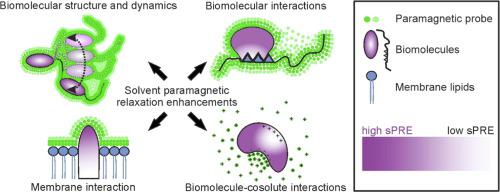Progress in Nuclear Magnetic Resonance Spectroscopy ( IF 6.1 ) Pub Date : 2022-09-21 , DOI: 10.1016/j.pnmrs.2022.09.001 Aneta J Lenard 1 , Frans A A Mulder 2 , Tobias Madl 3

|
Solvent paramagnetic relaxation enhancement (sPRE) is a versatile nuclear magnetic resonance (NMR)-based method that allows characterization of the structure and dynamics of biomolecular systems through providing quantitative experimental information on solvent accessibility of NMR-active nuclei. Addition of soluble paramagnetic probes to the solution of a biomolecule leads to paramagnetic relaxation enhancement in a concentration-dependent manner. Here we review recent progress in the sPRE-based characterization of structural and dynamic properties of biomolecules and their complexes, and aim to deliver a comprehensive illustration of a growing number of applications of the method to various biological systems. We discuss the physical principles of sPRE measurements and provide an overview of available co-solute paramagnetic probes. We then explore how sPRE, in combination with complementary biophysical techniques, can further advance biomolecular structure determination, identification of interaction surfaces within protein complexes, and probing of conformational changes and low-population transient states, as well as deliver insights into weak, nonspecific, and transient interactions between proteins and co-solutes. In addition, we present examples of how the incorporation of solvent paramagnetic probes can improve the sensitivity of NMR experiments and discuss the prospects of applying sPRE to NMR metabolomics, drug discovery, and the study of intrinsically disordered proteins.
中文翻译:

溶剂顺磁弛豫增强作为研究生物分子系统结构和动力学的通用方法
溶剂顺磁弛豫增强 (sPRE) 是一种基于核磁共振 (NMR) 的多功能方法,通过提供有关 NMR 活性核的溶剂可及性的定量实验信息,可以表征生物分子系统的结构和动力学。将可溶性顺磁探针添加到生物分子溶液中会以浓度依赖性方式增强顺磁弛豫。在这里,我们回顾了基于 sPRE 的生物分子及其复合物的结构和动态特性表征的最新进展,旨在全面说明该方法在各种生物系统中越来越多的应用。我们讨论了 sPRE 测量的物理原理,并概述了可用的共溶质顺磁探针。然后,我们探索 sPRE 与互补生物物理技术相结合,如何进一步推进生物分子结构测定、蛋白质复合物内相互作用表面的鉴定、构象变化和低种群瞬态的探测,以及对弱、非特异性、以及蛋白质和共溶质之间的瞬时相互作用。此外,我们还举例说明了溶剂顺磁探针的加入如何提高 NMR 实验的灵敏度,并讨论了将 sPRE 应用于 NMR 代谢组学、药物发现和本质上无序蛋白质研究的前景。构象变化和低种群瞬态的探测,以及对蛋白质和共溶质之间的弱、非特异性和瞬态相互作用的深入了解。此外,我们还举例说明了溶剂顺磁探针的加入如何提高 NMR 实验的灵敏度,并讨论了将 sPRE 应用于 NMR 代谢组学、药物发现和本质上无序蛋白质研究的前景。构象变化和低种群瞬态的探测,以及对蛋白质和共溶质之间的弱、非特异性和瞬态相互作用的深入了解。此外,我们还举例说明了溶剂顺磁探针的加入如何提高 NMR 实验的灵敏度,并讨论了将 sPRE 应用于 NMR 代谢组学、药物发现和本质上无序蛋白质研究的前景。
































 京公网安备 11010802027423号
京公网安备 11010802027423号